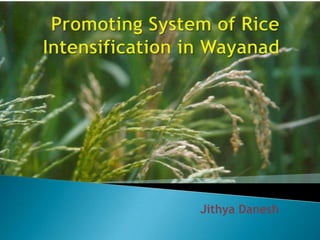
Promoting System of Rice Intensification (SRI) in Wayanad, Kerala
- 2. About Wayanad Issues System of Rice Intensification Pros and cons Lessons on scaling MGNREGA Future directions
- 3. The land of rice paddies- „wayal nadu‟ Intermingled hills and valleys with rainfed agriculture 35% forest cover One of the 150 most backward districts Tribal population is 17.5% Ranked in 25 eco-hotspots in the world Avg. height of 3000 feet Rainfall- 3000mm Paddy- integral part of culture of natives- Kurichyas, Kurumas, Chetties
- 4. Deforestation since the time of migrants Change in cropping pattern- Cash crops Falling productivity of soil Farmer suicides due to crop failure Increasing health issues among women and children Environmental issues External dependence on food items Low purchase power Threats from real estate mafia Rice, coffee, black pepper major crops- affected by monsoon
- 5. During 1970‟s, paddy grown in 40000 hectares, now less than 9000 hectares Shrinking wetlands Misuse of wetlands 55 Traditional rice varieties vanished Lack of food security and labour security for Indigenous communities Jobless women- lost 27 working days per acre per season Low productivity and high labour costs Area under rice replaced by banana
- 6. 1980 1990 2010 2000 Banana in rice fields have depleted the water sources resulting in severe water scarcity,
- 7. Change in seasons-agricultural crops Water scarcity becoming severe Floods and droughts- frequent Deficiency in rain- by 64% in the period from June 1 to July 11 this year
- 8. Need for alternatives One seed revolution
- 9. Developed by Father Henri de Laulanie, who studied various rice growing practices in Madagascar In Wayanad, Field trials with 27 farmers- promising results It can double the production of paddy per hectare by using 5% seeds, 50% of water, 50% of manure and 80% of labour. ◦ Transplantation: 2 week old seedlings ◦ Plant in equal distance of 30cm x 30cm or 25cm x 25cm ◦ Timely Water management
- 10. SRI will serve as a better option for areas deficient of water and where rice is a major crop. SRI is found to be managing the soil, water and plant in a balanced ecosystem This technique is gaining popularity and giving promising results to the farmers There are many visible changes in adaptation which can render more possibilities to the rice growers of this “Wayal nadu”.
- 11. 8-14 days old seedlings taken with the mud. Select strongest seedlings from seed bed. Fast transplantation-within 30 minutes without damaging root system
- 12. One seedling in one clump, transplanting at 25cm x 25cm. Good soil landing before transplantation
- 13. SRI field among other fields: initial week
- 14. After transplanting After 15 days After one month
- 15. Emerging tillers Upto 60 tillers arise from a single hill…!
- 16. Dry field Water management is crucial in SRI. Except in swampy fields, the fields are flooded in the morning and drained in the evening. Water is allowed to remain in the fields for few hours only
- 17. Do weeding regularly Because field is not always submerged in water Manual weeding or use conoweeder 2-3 times
- 20. SRI NON-SRI Plant height 130.29cm 101.57cm Yield/acre 3042kg 1874kg No.of tillers 40-80 20-30 Plant/sqm 17 (25cm) 36 (12cm) Transplanting 12.5 days/acre 10days/acre Weeding 25 days/acre 12 days/acre
- 21. Increased yields (upto 8750Kg/acre) 40% to 110% Increased factor productivity (land, labour, water, seeds)- sustainable Water requirement can be reduced by half More farmers can share available water Higher profits (5000 to 8000 INR more) 75% to 240% Seed cost very low Positive environmental side effects Maintenance of greater agrobiodiversity Mitigating climate change by reduced water storage With more spacing more resistance to abiotic stress
- 22. Increased labour requirement for weeding, transplanting and water management More weeds in summer (Dec- May) Non-availability of water control measures Greater skills required Low adaptation
- 23. Results were shared amongst farmers as well as expert groups- well appreciated Master farmers- as extentionists- more areas covered Local Panchayat impressed- wanted to replicate Lessons from elsewhere shows good results- Tamilnadu, Andra pradesh. Countries such as Thailand, SriLanka, Cambodia very successful
- 24. Kaniyambetta Panchayat decided to cultivate in 10 acre 20 farmers selected Rs.3000/ acre/person In joint hands with Agriculture Department Deepening democracy at the grassroots by strengthening PRIs In NREGA- The order of priority of works will be determined within the Grama Panchayat.
- 25. In the new proposed guidelines by Mihir Shah Committee, (Feb 2012) in additional list of permissible works under the MGNREGA, under the agricultural related works, SRI (System of Rice Intensification) is mentioned. The guidelines states that each farmer (qualifying for support under MGNREGA) willing to try out SRI will be eligible for 8 person-days of work per acre for one-time transplantation, 2 person-days of work per acre for weeding at 10 to 15 days after transplantation and 2 person-days of work per acre for weeding at 20 to 30 days after transplantation.
- 26. Potential political responses- linking of short term and long tem policy targets to ensure incremental progress Societal reach- fundamental change required- Govt. leadership role, incentives Scientific uncertainty- educate decision makers and public
- 27. Thank you
Editor's Notes
- Rice Paddy to banana :Impact on Women and Tribal CommunitiesWomen lost 15,50,000 labour days per season.Banana offers no labour opportunities for women.Food security of the poor communities affected.High use of toxic chemicals in banana fields contaminated water sources as well as creating health hazards among women and children(Rice can hold water for 90 days in the Field).
